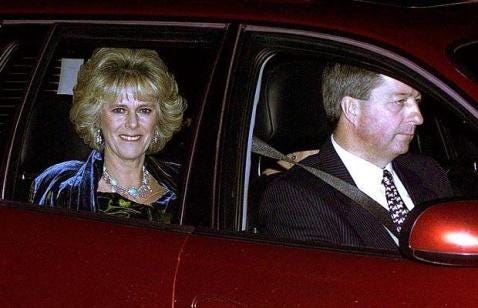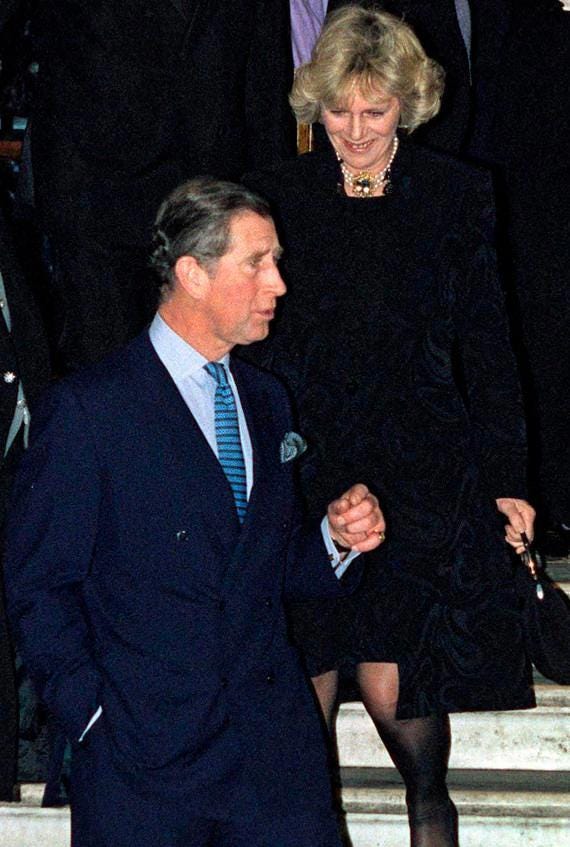An important moment for Charles and Camilla that The Crown may overlook
In September 1999, two years after the death of Diana, Princess of Wales, Camilla Parker Bowles took a significant step toward public acceptance with the help of friendly Americans
I’m sure many readers of Royals Extra are watching the final season of The Crown. Last Thursday, The Times of London published my analysis separating fact from fiction in the first four episodes, which covered the dramatic events of just one year—1997—ending with Diana’s death in a horrific car crash on August 31st and the immediate aftermath. I’m not allowed to reprise in Royals Extra what I wrote, but here’s a link to the piece in The Times for those who are interested:
How accurate is The Crown season 6? Sorting fact from fiction
I’ll be doing a similar dissection that The Times will publish on Thursday December 14th, when the last six episodes are released. I won’t be able to share that either, but I’ll also post a link on Royals Extra.
In the meantime, I’ve been thinking about what may or may not appear in the new episodes, which are expected to cover eight years, ending with the marriage of Prince Charles to Camilla Parker Bowles in April 2005.
One theme threading through the first four episodes was an effort by Charles and his “spin doctor,” Mark Bolland, to bring Camilla out of the shadows and steer the public toward recognizing her importance for the prince. That campaign ended abruptly with Diana’s death.
Charles and Camilla’s romance moved underground again immediately. Charles canceled a well-publicized holiday with Camilla at Birkhall, his home in Scotland, and she initially stayed away from Highgrove, his Gloucestershire estate.
Early in 1998 Camilla began to appear at private dinners Charles hosted at Sandringham, the royal estate in Norfolk, and then at Highgrove and St. James’s Palace, the prince’s London home. When Charles turned fifty that November, he was celebrated with six parties, including one on his birthday eve for 850 guests at Buckingham Palace hosted by his mother and father.
But the main event for Charles was at Highgrove on the night of his birthday, November 14th, when Camilla, the official hostess, was photographed arriving in one of Charles’s limousines. Complementing her low-cut green velvet gown was a gorgeous necklace and matching earrings of diamonds and cabochon turquoises that had belonged to her great-grandmother, Alice Keppel, a mistress of Charles’s great-great-grandfather, King Edward VII.
The Queen, Prince Philip, and Charles’s siblings stayed away, although Princess Margaret was among the 300 guests. Significantly, Prince William and Prince Harry also attended. Will Trinkle, an American friend of Charles and Camilla who went to the party, told me that Princess Margaret’s presence “was a great vote of confidence for Charles.”

The evening featured comedy routines by Rowan Atkinson and Stephen Fry, and the birthday cake was decorated like a garden. After the fireworks, the guests danced to disco hits from the nineties, including Abba’s “Dancing Queen.” The party didn’t break up until 3 a.m., and Camilla stayed at Highgrove, as did William and Harry, who had met her for the first time the previous summer.
Some six weeks later, on the evening of January 28, 1999, in an appearance meticulously choreographed by Mark Bolland, Charles and Camilla were photographed officially as a couple when they left the Ritz Hotel in London, where they had attended a fiftieth birthday party for Camilla’s sister, Annabel Elliot.
Over the following months, they were seen together from time to time---foxhunting in East Yorkshire, attending a Royal Shakespeare Theatre production in Stratford-Upon-Avon—but they kept their profile low.
What Mark Bolland called a “testing ground for public opinion” occurred in September 1999, not in London but in Manhattan. Bolland recommended, and Camilla agreed, that a private visit to New York City could be symbolically important. It was a bold move. Manhattan had long been considered Diana’s territory, a place where she had been admired and celebrated. Only two months before her death, she had appeared at Christie’s to publicize an auction of seventy-nine of her cocktail and evening dresses to benefit the AIDS Crisis Trust.
Cultivating American support was an essential ingredient in Bolland’s strategy to rehabilitate Camilla’s image. Through the Prince of Wales Foundation established in Washington, D.C. by Robert Higdon, a veteran American fundraiser and impresario hired by Charles in 1997, well-heeled patrons, most of them from the United States, began donating $20,000 per couple to Charles’s favorite causes. He rewarded their generosity by entertaining them at lavish dinners arranged by Higdon at royal residences. Will Trinkle and his partner Scott Bessent, a wealthy financier, were among the prince’s early benefactors. They were also good friends of Mark Bolland.
Camilla and Bolland flew by Concorde (at a cost of $10,000 per ticket, paid by the prince) to New York on Sunday, September 19, 1999. Her first stop, for relaxation and to ease her jet lag, would be the East Hampton home of Bessent and Trinkle. A year earlier, Camilla had given the couple lunch at Ray Mill, her home near Highgrove. “It was very casual and easy,
Keep reading with a 7-day free trial
Subscribe to ROYALS EXTRA BY SALLY BEDELL SMITH to keep reading this post and get 7 days of free access to the full post archives.




